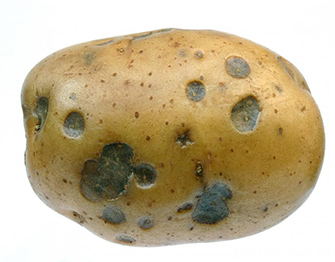Please click here to access the main AHDB website and other sectors.
- Home
- Knowledge library
- Pit rot
Pit rot

Pit rot is a grouping of defects with similar looking symptoms. The name refers to the old fashioned straw-covered potato pits or clamps from which the problem was particularly noticeable.
Poor ventilation, high carbon dioxide and low oxygen levels are likely to contribute to the problem. It is not yet understood why a particular stock succumbs.
As well as this physiological defect, certain active pathogens have also been found associated with pit rot lesions.
Physiological pit rots are small (usually 2-6 mm in diameter) round, dark sunken lesions centred on lenticels. The blackleg causing Pectobacterium species can cause indistinguishable pit rotting where lenticels are infected but too dry for soft rot development.
Other associated organisms are usually weak opportunistic pathogens including non gangrene causing Phoma species and Cylindrocarpon. Lesions infected with Cylindrocarpon can expand to larger sunken lesions resembling gangrene but usually more circular and not centred on a physical wound. The infection can extend into the tuber as a moist dark brown, hemispherical rot radiating from the lenticel entry point.
Measures to control pit rot would involve the prevention of water logging in the field, rapid drying in store and ensuring adequate ventilation. Some varieties e.g. Desiree and Cara are more prone to the defect.

